Introduction
An Ornamental Lake was an integral part of the designs for the new Alexandra Park submitted by Henell in 1869. Located in the south-west of the park, its two-and-a-half-acre span was dotted with ‘extensive rockeries’ and ‘supplied by water from the drainage of the grounds.’The area was locally know as 20 pits, due to the wet clay soil and the existence of a number of marl-pits. Although the ‘ornamental lake’ may have been included for aesthetic purposes and for city dwellers to enjoy water in nature, throughout its history, it acted as the site of many leisure pursuits from skating in the winters of the nineteenth century, to summer fishing in the twentieth. In 1878 the park minutes record discuss the use of miniature of model boats on the lake and that funds of £1 were to be made available to repair these miniature craft, but only if they became park property. Just as important were the recreational activities which did not happen, such as summer bathing, which give an indication of wider debates in Manchester about the purpose of parks and how people should relate to them.
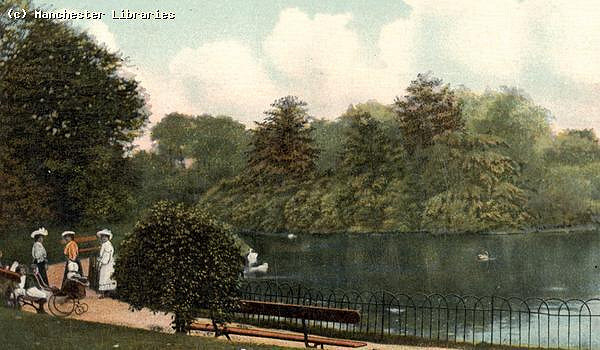
The lake 1900
Courtesy of Archive Plus
Ice Skating in the park
The delights of the Ornamental Lake were noted in reports of the parks opening and frequently in Whitsuntide reports in the 1870s. However, for some visitors, the smooth waters of the park provided opportunities to do more than admire and spectate. On December 6 1871, ‘A Skater’ wrote to The Manchester Guardian suggesting that the new park could admit skaters onto the frozen waters in the southwest quarter in the evenings after work. This, he said, ‘would be a source of enjoyment to many who are engaged at work during the day’ and would be ‘another boon gratefully received by the young men of the district.’Perhaps unknown to ‘A Skater’, the subcommittee relating to Alexandra Park had already discussed this notion at their meeting of December 1 and in the large Parks Committee meeting on December 8, the subcommittee was permitted to implement any regulations on ice skating in the park that they saw fit. No change in regulations is noted in the minutes and there is no acknowledgement of it occurring in the park itself.
By the mid 1870s, skating had become a popular pastime in the Alexandra Park district. In the December of 1874, The Manchester Guardian noted that the hard frost had seen ‘youths and maidens, carrying skates and wending their way to and from some pond or other piece of water.’ These included the gardens in Belle Vue and an ‘artificial sheet of water’ in Alexandra Park. In 1875, the skating boom had seen a new rink developed near Alexandra Park for year-round use. This 2,000 square yard facility consisted of an iron roof and Val-de-Travers paving and had exclusive rights to use the new Plimpton roller skate, with a permanent instructor appointed to help hapless customers. Within a month, the Manchester Evening News suggested the new rink had become an institution within the city. In addition to the aquarium, which graced the district, Alexandra Park was becoming a centre for leisure and entertainment.
The park also developed into a space for skating. In 1875, a letter from ‘Skater’ on behalf of ‘a large number of skaters of both sexes and all ages’ requested that the rough ice on the lake be flooded with water in order to create a flat sheet of ice, which would ‘prove a greater attraction than the most beautiful of flower beds’. Given that the correspondent requested a pump to spread this new layer of water, and no record of this occurring exists, it is unclear whether Skater’s request was followed. However, other reports outline that skating on the park’s lake occurred in the late 1870s. In December 1878, The Manchester Guardian reported on the death of local footballer and sprinter, John S. Scott, adding that just 10 days previously, the reporter had conversed with him while skating on the ice in Alexandra Park. In 1879, The Manchester Times reported on hundreds of people ‘indulging in healthy exercise’ on the frozen lake. Not all agreed the practice was as ‘healthy’ as the Times suggested. On the same day as the report of hundreds of people taking exercise on the lake, the Manchester Courier and Lancashire General Advertiser published a letter from ‘Senex’ under the title ‘Cursing and Skating in the Parks’. While skating was one of the few activities that Victorian society allowed men and women to do in public, Senex outlined the peril that ‘a decent female’ might expect in Alexandra Park. Unless ‘her eyes are proof against the foulest language, and her eyes to the most glaring immorality’ the writer thought it would be difficult for the ‘decent female’ to show herself in the park after dusk. The reason for this letter was a hastily abandoned family trip to the ice in Alexandra Park, ruined by ‘beastly language’ and a plea to the Corporation to both put signs up and ‘make an example of a few cads caught in the act’; this would promote the comfort of the ‘tax paying few’. Such reports offer glimpses of daily life in park in the winters of the 1870s. Skating was clearly a common and popular occurrence when the weather allowed. However, the ice was also a temporary space that, perhaps, seemed beyond the usual rules of the park and could be prone to social conflict.
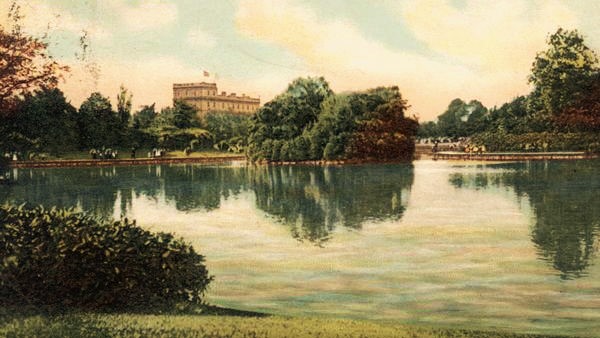
The lake 1900 with St Bede’s in the background
Courtesy of Archive Plus
In the 1880s, ice skating continued in the winter months with a fee charged to enter the ice. On December 8, 1882, the Alexandra Park Sub-Committee noted that skating in the park would be open from 6-10 in the evening, excluding Sundays, and would cost 6d per person with tickets to be sold by the Park Keeper, Mr Manderson. Costs remained stable in the first half of the decade, however, for some, an increased fee would help exclude those not desired on the ice. In December 1884, HHJ noted with regret that attempts to go skating after work for 6d had been hampered by the unexpected closure of the ice. This correspondent believed it could be kept open until at least 10 or 11 at night for a small fee and that it could ‘be kept select’. The links between payment and opportunity continued into the 1890s. In 1890 ‘A City Ratepayer’ demanded an explanation for the early closure of the ice which ‘debarred [ratepayers] from enjoying such a healthy exercise as skating affords.’ Throughout the 1890s, the opening hours of the temporary winter rink on the ornamental lake were a source for letters to the local press, with questions about its closure on Sunday and its early closing times during the week. While the park had been opened as a park for the people, those who paid tax and those who could afford a little more expected the park to be open for people more like them at times which suited them. When St Bede’s College first opened, the Bishop of Salford came to stay at the establishment, he had a great love of ice-skating and is recorded in 1897 as staking on the lake. As the Victorian period drew to a close, rational recreation was increasingly making way for the recreational consumer.
The 1874 bathing debate
In 1874, the Alexandra Park lake became the centre of a debate about the provision of bathing and washing facilities in the city of Manchester. Although later reports do not indicate that swimming or bathing ever occurred in the park, the debate indicates the central role that the new park played in public questions about health and cleanliness. In mid-July 1874, ‘A Bather’ noted in a letter to the Manchester Evening News that Manchester had a lack of bathing space and that the waters of Alexandra Park would be ideal, particularly in the mornings between 6 and 8. In the weeks following, other correspondents wrote to the paper with some criticising Manchester’s filthy waters, the lack of bathing facilities for women and danger to life, and others wanting to underline the benefits of swimming. For many, it seemed that Alexandra Park offered a simple solution. The park lake, said one writer, could be used to teach children to swim and opening it in the morning to swimmers would encourage many to get up in the morning, after all, they said, ‘what is more healthier [sic] than having a bathe before breakfast?’ This would ensure a cleaner population and cleanliness was the ‘best promotor of health’. Though the debate seemingly died down and the lake was not opened for public bathing, the brief excitement in the summer of 1874, demonstrated that Alexandra Park was seen by some citizens as a solution to a range of public health problems. Just four years after opening, it was hoped that the park’s ornamental lake would provide a practical space to teach lifesaving, to swim, and to get clean. That it did not meant the Corporation, and Manchester’s citizens, would have to turn elsewhere. Swimming was finally allowed in the park with the arrival of the lido in 1930.
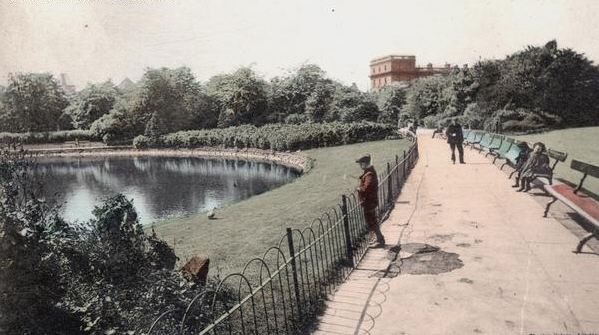
The lake 1907
Courtesy of Archive Plus
The twentieth century: A ‘Fishermen’s Mecca’
In June of 1914, the Parks Committee opened up the Alexandra Park to a new, increasingly popular, leisure activity; fishing. The first set of anglers, on 16th June 1914, pounced at their opportunity and surrounded the banks of the lake, even posing for a photo for the local press at the new ‘Fishermen’s Mecca’ (see below). Estimates from The Daily Citizen suggested that around 100 anglers dressed in blue overalls, shirt-sleeves and armed with rods, nets and bags, had flocked to Alexandra Park, paying 6 pence to attempt to uncover the mysteries of the lake. Throughout the day, the crowd brought out carp, gudgeon, and one ‘a choice sample of bream, probably weighting between one and a half and two pounds.’ As with all park activities, fishing also came with rules. While the 6 pence provided 15 hours of fishing from 6 in the morning until 9 at night, fishermen were reminded to replace fish of less than 7 inches and prohibited from taking trout from the lake – even though the existence of the latter in the lake was very much debated in fishing circles. The prize catch, the so-called ‘patriarch of the pond’ was a tench which a Mr Pickwell had caught in Dunham Park and placed in the lake around the turn of the century.
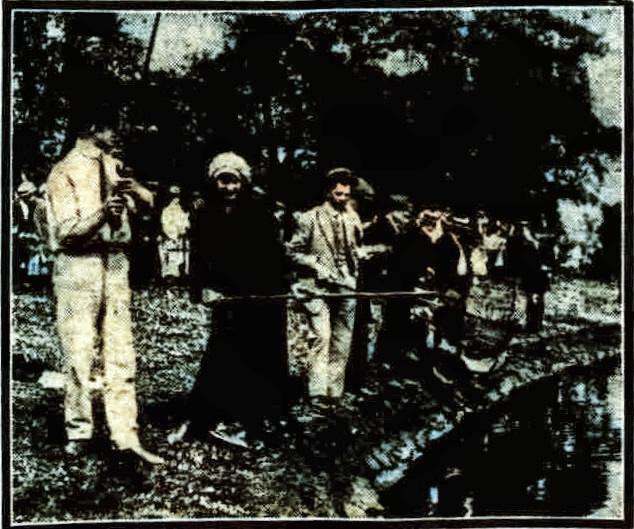
Fishermen’s Mecca
or many years anglers have looked with longing eyes on the fish in Alexandra Park lake, Manchester.
The Parks Corporation have not granted facilities for fishing in the lake, and the first anglers made their appearance yesterday
Our picture shows a fair assistant landing a large catch.
Source:Daily Citizen 17 June 1914
For the devotees of fishing in Manchester, the Corporation’s decision to open the lake to anglers met with favour. In a letter to the Manchester Evening News, one correspondent urged the Corporation to ensure a full stocking of Manchester’s waters, asking why they did not support Manchester anglers as other places had done. However, the first week of fishing did not pass without criticism. Writing to The Manchester Guardian ‘B’ questioned the morality of allowing fishing as a sport in the park. If the rules on size of fish were obeyed, the writer outlined, ‘nine out of every ten’ fish would be returned to the lake to be ‘caught over and over again.’ While catching fish for eating was justifiable, B. considered fishing to be ‘a monstrous barbarity’. Other reports focused on the behaviour of the fishermen themselves. Talbotanian, in a letter to the Manchester Evening News, agreed saying that the ‘lake environments, which should be at their best, have in much less than a week been ruined, and what were recently delightfully green slopes are now rusty and woebegotten.’ The Corporation was said to have ‘blundered’ and the author requested the ‘trial’ to be ended. While noting the success of the fishing in the lake, including the catching of ‘two huge roach’, the Daily Citizen, added that some fishermen had been ‘guilty of the most reprehensible conduct, trampling shrubs down and actually pulling them up to find worms.’ This, they warned would mean that fishing rights would not be extended elsewhere by the Corporation. The Daily Citizen were right, and not only were the rights not extended, but the one’s granted in the Alexandra Park lake were withdrawn. While some anglers complained, a further article in the Daily Citizen indicated that the entire ‘affair has been a disgrace to anglers generally, and Manchester anglers in particular.’ The great Alexandra Park fishing experiment seemed to have ended.
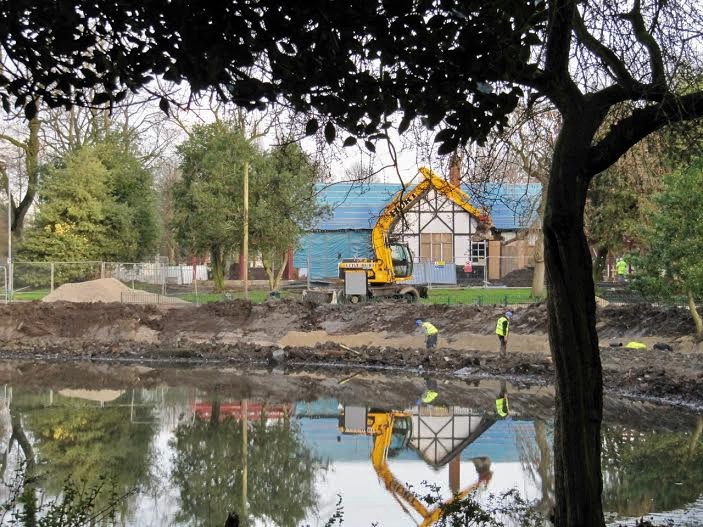
During the restoration
Image copyright of Phil Benson-Hannam
Pre/post Restoration
Prior to the restoration of Alexandra Park, a few independent fishermen still used the lake for their sport. By this time the water was still of a good quality and was home to a number of pike, which had been introduced to the lake by the fishermen. Also a large colony of Red Snapper Turtles appeared in the 80’s, due to the craze of the time Ninja Warrior Turtles, these creatures ultimately becoming to large to live in a home aquarium were ‘released’ into the wild into the lake.
During the restoration the lake was drained by 2/3rds of its water, what was revealed were masses of fresh water mussels, which helped with the aeration of the water. The accumulation of years of rubbish (shopping trollies, bags, cans, bikes etc) were removed, and at the same time the rule was that any ‘Alien Species’ found in the lake would be removed and rehomed, but surprisingly the turtles were very adept at hiding, so were not found, and are still a feature of the lake today.
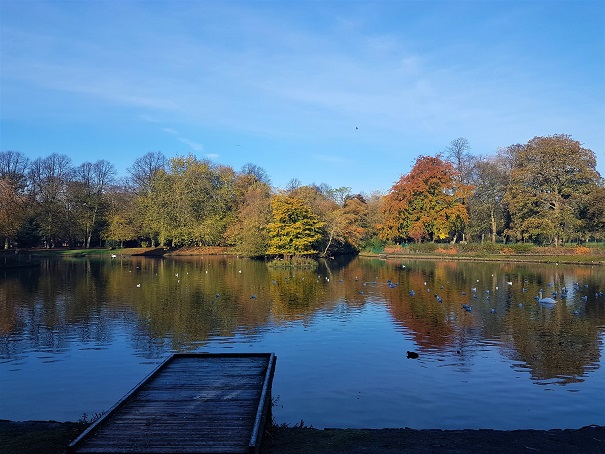
September Lake
Image copyright of Ros Wolfe
As part of the restoration new fishing jetties were created to encourage back local fishermen, and the lake was restocked with fish. The pike returned somehow and can be seen cruising in the water on a sunny day. As of today, the Alexandra Park Manchester Wildlife Group have been replanting the banks with plants more suited to the area. The first of the floating islands has been installed in one part of the lake, to allow the plant roots to become nurseries for breading fish and to help with the biodiversity of the water. The lake today is still a peaceful, tranquil place to sit and dream, just as the Victorians/Edwardians did.
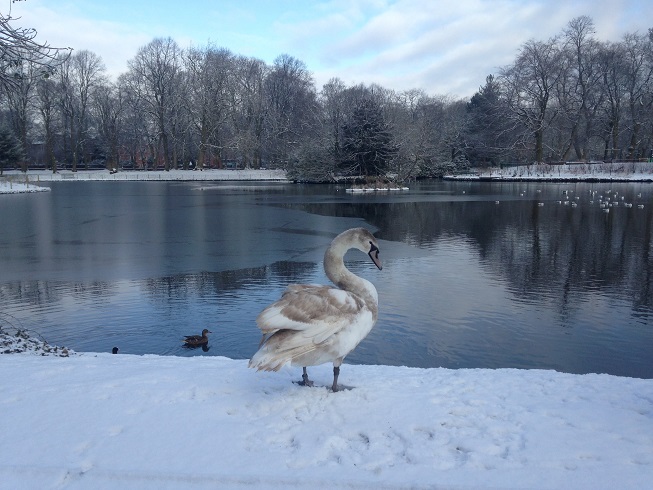
December Swan
Image copyright of Max Rawlings
Summary
The Ornamental Lakes, while designed to provide a scintillating aesthetic addition to the park, developed into an important leisure and recreational space. In the cold winters of the nineteenth century, skaters flocked to the ice of the lake as skating of all forms boomed in Manchester. But the new spaces were not immune to the conflicts that occurred elsewhere in society and the ice saw calls for exclusions and regulations to ensure that those who paid were not discomforted by ‘rowdy’ or ‘rough’ behaviour. For some citizens, the lake also seemed to offer a solution to Manchester’s ‘filthy’ bathing waters. While the bathing debate died down quickly, it demonstrated that in a short period of time, Alexandra Park had become central to debates about public health in the city. In the early twentieth century, the lake briefly served as a location for the growing number of anglers to try their hands. Rough treatment of the flowerbeds and grass quickly put an end to the fisherman’s Mecca in south Manchester, but raised questions of ownership, as ice skating had in the previous century; just which public was the park for? Was it for the ratepayer or the rowdy rough, the angler, or the Talbotanian? How this question is answered remains at the centre of public park provision today.
Article © of Alexandra Park Research Team

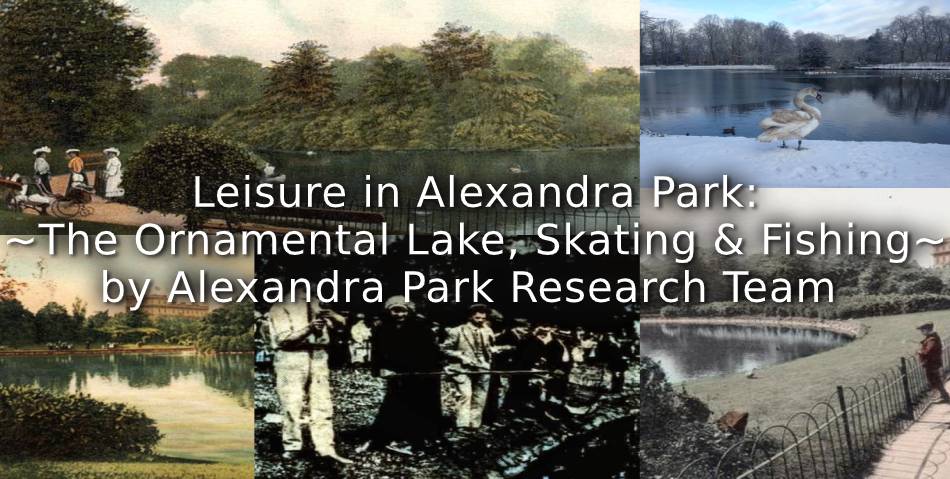


![“And then we were Boycotted”<br>New Discoveries about the Birth of Women’s Football in Italy [1933] <br> Part 7](https://www.playingpasts.co.uk/wp-content/uploads/2020/09/Marco-Part-7-Boycotted-440x264.jpg)
